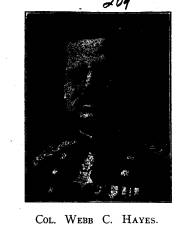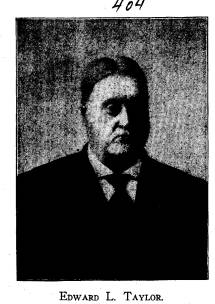Ohio History Journal
|
EDITORIALANA. |
|
|
|
TRUSTEE MEETING AT SPIEGEL GROVE. On Thursday, June 30th, the Trustees of the Ohio State Archaeo- logical and Historical Society held a regular meeting at the residence of Colonel Webb C. Hayes, Spiegel Grove, Fremont, Ohio. It was a most |
|
|
|
Miss Lucy E. Keeler-all members of G. A. R. Hon. J. C. Wonders, Chief of the Ohio State Highway Commission, was also the guest of Colonel Hayes. The entire party were comfortably bestowed in automobiles and whisked over the country roads, to the site of Fort Seneca, within the present precincts of the village of Old Fort, romantically located on the banks of the Sandusky River. Here the party traced the lines of the old fort, under the guidance of some of the elder inhabitants, one a genial well-preserved gentlemen, upwards of four score years of age, Mr. Hiram Risden, "born and raised on the spot," and who as a boy saw the fort picket walls and blockhouse defenses still standing. Mr. Risden's father -Joel Risden-located here, coming from Vermont in 1810. This was 319 |
320 Ohio Arch. and Hist. Society Publications.
the headquarters of General Harrison,
during an important period of
the 1812 war. The defense known as Fort
Seneca was erected early in
July, 1813, and contained within its
enclosure about one and one-half
acres of land. The position of the fort
was both a picturesque and
a practical one, being situated upon the
bank about forty feet above the
bed of the Sandusky river.
On the return to Fremont, the party made
a stop at the location
of Ball's Battlefield, where Colonel
Ball with a detachment of troops,
on their way to the Maumee, a day or two
before the assault on Fort
Stephenson, met a band of Tecumseh's
Indians. The encounter was
somewhat unique in as much as the
mounted soldiers with drawn sabres
charged into the Indian ranks and cut
them to pieces before the savages
could get their flint lock guns into
working order. The site of Ball's
battle is to be appropriately
"monumented" by the Daughters of the
American Revolution, who have already
placed in position an immense
bowlder, upon which suitable descriptive
tablets will be attached.
The Trustees were most hospitably
entertained at Spiegle Grove the
evening and night of the 29th. At 8:30
a. m., Thursday, the Board meeting
was held in the spacious parlors of the
Hayes residence, so interestingly
and inspiringly stored with relics of
the wars of '76, 1812 and '61 to
'65. Like knights of the historic Round
Table the Trustees gathered
in this room, where have been received
at various times so many dis-
tinguished members of the official,
civil and military circles of our nation.
The splendid features of Rutherford B.
Hayes, at one time President
of our Society, and always its ardent
advocate, seemed to gaze ap-
provingly upon the proceedings of the
meeting. The Trustees present
were: M. R. Andrews, G. F. Bareis, A. J.
Baughman, H. E. Buck, R.
E. Hills, J. W. Harper, B. F. Prince, L.
P. Schaus, H. A. Thompson,
W. C. Mills, G. F. Wright and E. O.
Randall. The main business in
hand was the acceptance of the deeds
from Colonel Hayes, completing
in prospect the transfer of the entire
Spiegel Grove property, of some
twenty-five acres, to the State of Ohio,
for the benefit and the cus-
todianship of the Ohio State
Archaeological and Historical Society.
One year ago Colonel Hayes made over ten
acres of the property, em-
bracing the Harrison Trail. The two
deeds now submitted and accepted
by the Society, transfer the additional
ten acre strip facing on Hayes
and Wilson avenues, and a separate deed
for the remaining five acres,
including the famous and magnificent
Hayes residence, with its price-
less treasure of relics and books. Conditions of this princely and
patriotic gift are, that the State or
the Historical Society shall properly
maintain the property and home, allowing
the lineal descendants of the
late President Hayes to occupy the
residence when they choose and
that the State or Society shall erect a
fireproof library building to con-
tain the library, which in Americana is
perhaps the richest private collec-
tion in this country.
Editorialana. 321
Mr. Birchard A. Hayes of Toledo, Ohio,
and Mrs. Fanny Hayes
Smith of Annapolis, Md., oldest son and
only daughter respectively of
the late President Rutherford B. Hayes,
were elected life members of
the Society.
At the adjournment of the meeting, under
the chaperonage of
Colonel Hayes, the party again resorted
to automobiles, and accompanied
by several other guests including many
of the Daughters of the Ameri-
can Revolution, who were in the party of
the previous day, all proceeded
to Port Clinton, where dinner was served
at the hotel. An inspection
was then made of the historic
carrying-place, leading from the mouth
of the Portage River on Lake Erie across
the projecting neck of land
to Sandusky Bay.
It is proposed to mark the northern
portion of this old Sandusky-
Scioto land trail--leading from Lake
Erie to the Ohio River, along the
west bank of the Sandusky-Scioto
watercourse,-by erecting two simple
bowlder monuments on what is called the
De Lery portage of 1754, ex-
tending from Lake Erie across the
Marblehead peninsula to Sandusky
Bay, opposite the mouth of the Sandusky
River. This portage is ap-
proximately represented by Fulton Street
of the city of Port Clinton
with its extension north, an ordinary
country road, from the city limits
south to Sandusky Bay.
Old Fort Sandusky, built in 1745, was
near the southern end of this
portage and General Harrison's army
embarked for the Canadian cam-
paign, terminating in the Battle of the
Thames, from the northern end
of this portage, at which point his
troops also were embarked on
Commodore Perry's ships soon after the
battle of Lake Erie. The citi-
zens of Port Clinton propose to erect a
split bowlder monument on
the shores of Sandusky Bay at the south
end of the De Lery portage,
at the site of Old Fort Sandusky. And
the Ohio Society of Colonial
Dames of America have secured a fund for
the construction of an
historical tablet to be placed on one of
the faces of the monument. It
is agreed that the Ohio State
Archaeological and Historical Society
place on this monument a tablet of
similar size, descriptive of the events
happening on this site, and also two
small tablets, one containing the
roster of the officers of the French
expedition of 1754 and the other
the roster of the first British
expedition of 1760, when America was
taken over by Great Britain from France.
At the northern end of the portage a similar
monument will be
erected by citizens of Port Clinton, on
which the Ohio Society, Daugh-
ters of the American Revolution, will
place a tablet for which a sum
has been provided, and it is decided
that a tablet of similar size also
descriptive of the battle of Lake Erie,
be erected by the Ohio State
Archaeological and Historical Society,
and also two smaller tablets, one
containing a roster of the officers of
Major General Harrison's army
Vol. XIX-21.
|
322 Ohio Arch. and Hist. Society Publications.
and the other the officers of the American fleet of Commodore Perry and the British fleet of Captain Barclay. The day's outing was delightfully closed by a steam-yacht trip from Port Clinton to Put-in-Bay, where a short stop was made and a glimpse taken of the proposed site of the monument to be erected in September, 1912, commemorative of Perry's encounter on Lake Erie.
EDWARD LIVINGSTON TAYLOR. An innumerable host of admiring acquaintances heard with regret; and a wide circle of intimate friends learned with sincere sorrow of the sudden death of Edward Livingston Taylor, who unexpectedly passed to the great beyond on the evening of Sunday, May 29th (1910.) His was no ordinary character; his abilities were of an unusual order; his qualities of sociability and friendship bound him in the closest |
|
|
|
the frame house then constructed for their home, still stands, one of the oldest landmarks of early settlement in the state, and it is still in the possession and occupancy of the Taylor family. This Truro township is historic, for it lies in the "Refugee Tract," a strip of land four and one-half miles wide from north to south and about fifty miles from east to west, extending from the east bank of the Scioto River to near the |

